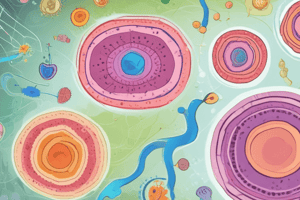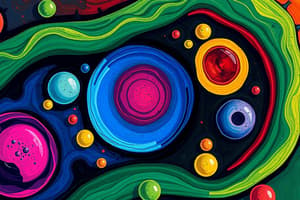Podcast
Questions and Answers
What is the primary function of the cell membrane?
What is the primary function of the cell membrane?
- To provide structural support
- To synthesize proteins
- To control the movement of substances in and out of the cell (correct)
- To store waste materials
Which structure is responsible for storing water and nutrients in plant cells?
Which structure is responsible for storing water and nutrients in plant cells?
- Vacuole (correct)
- Lysosome
- Ribosome
- Mitochondria
Which of the following components is found in the Golgi apparatus?
Which of the following components is found in the Golgi apparatus?
- Cell wall
- Chlorophyll
- Transport vesicles (correct)
- Ribosomes
What is the primary role of mitochondria in a cell?
What is the primary role of mitochondria in a cell?
What is the function of the nucleolus within the nucleus?
What is the function of the nucleolus within the nucleus?
What type of organelle is the endoplasmic reticulum, and what is its primary role?
What type of organelle is the endoplasmic reticulum, and what is its primary role?
Which of the following is NOT a function of lysosomes?
Which of the following is NOT a function of lysosomes?
Which component is essential for carrying out photosynthesis in plant cells?
Which component is essential for carrying out photosynthesis in plant cells?
What is the primary function of the cytoskeleton in a cell?
What is the primary function of the cytoskeleton in a cell?
Which structure is characteristic of prokaryotic cells?
Which structure is characteristic of prokaryotic cells?
What component is unique to plant cells compared to animal cells?
What component is unique to plant cells compared to animal cells?
In which cellular structure does cellular respiration primarily occur?
In which cellular structure does cellular respiration primarily occur?
Which molecule serves as the primary energy carrier in cells?
Which molecule serves as the primary energy carrier in cells?
Which process is specifically used by plants to produce glucose?
Which process is specifically used by plants to produce glucose?
What type of molecule is RNA, and what is its primary role?
What type of molecule is RNA, and what is its primary role?
Which of the following describes enzymes?
Which of the following describes enzymes?
Flashcards
Cell Membrane
Cell Membrane
A cell's outer boundary, controlling what enters and exits.
Cell Wall
Cell Wall
Rigid outer layer found in plant cells; provides support.
Nucleus
Nucleus
Control center of the cell; contains DNA.
Mitochondria
Mitochondria
Signup and view all the flashcards
Ribosomes
Ribosomes
Signup and view all the flashcards
Endoplasmic Reticulum (ER)
Endoplasmic Reticulum (ER)
Signup and view all the flashcards
Golgi Apparatus
Golgi Apparatus
Signup and view all the flashcards
Chloroplast
Chloroplast
Signup and view all the flashcards
Cytoskeleton
Cytoskeleton
Signup and view all the flashcards
Prokaryotic Cell
Prokaryotic Cell
Signup and view all the flashcards
Eukaryotic Cell
Eukaryotic Cell
Signup and view all the flashcards
Plant Cell
Plant Cell
Signup and view all the flashcards
Animal Cell
Animal Cell
Signup and view all the flashcards
Cellular Respiration
Cellular Respiration
Signup and view all the flashcards
Photosynthesis
Photosynthesis
Signup and view all the flashcards
ATP
ATP
Signup and view all the flashcards
Study Notes
Cell Structure
- Cell Membrane (Plasma Membrane): A semi-permeable membrane surrounding the cell; regulates substance movement (e.g., transport proteins).
- Cell Wall: A rigid outer layer in plant cells, fungi, and some bacteria; provides support and protection (e.g., cellulose fibers in plant cells).
- Cytoplasm: The gel-like substance within the cell membrane; contains all cell components and organelles (e.g., ribosomes, mitochondria, cytoskeleton).
- Nucleus: Membrane-bound organelle in eukaryotic cells; contains the cell's DNA (e.g., nuclear membrane).
- Nucleolus: A dense region within the nucleus where ribosomes are made.
- Mitochondria: Organelles that produce energy (ATP) through cellular respiration (e.g., cristae, the inner membrane folds).
- Ribosomes: Small structures that make proteins by translating mRNA.
- Endoplasmic Reticulum (ER): Network of membranes involved in protein and lipid synthesis.
- Rough ER: Studded with ribosomes; involved in protein synthesis.
- Smooth ER: Lacks ribosomes; involved in lipid synthesis and detoxification.
- Golgi Apparatus: Modifies, sorts, and packages proteins and lipids for secretion or delivery to other organelles (e.g., vesicles).
- Lysosome: Organelles with digestive enzymes; break down waste materials and cellular debris (e.g., acid hydrolases).
- Vacuole: Membrane-bound sac for storage, waste disposal, and maintaining turgor pressure (e.g., water, nutrients, waste).
- Chloroplast: Organelles in plant cells; carry out photosynthesis (e.g., chlorophyll).
- Cytoskeleton: Network of protein fibers maintaining cell shape, securing organelles, and enabling movement (e.g., actin filaments, microtubules, intermediate filaments).
Cell Types
- Prokaryotic Cell: Lacks a nucleus and membrane-bound organelles (e.g., bacteria, cell wall, single circular DNA).
- Eukaryotic Cell: More complex; has a nucleus and membrane-bound organelles (e.g., animal cells, plant cells, fungi, protists).
- Plant Cell: Eukaryotic; has a cell wall, chloroplasts, and a large central vacuole.
- Animal Cell: Eukaryotic; lacks a cell wall and chloroplasts but has lysosomes and centrioles.
Cell Processes
- Cellular Respiration: Cells convert glucose and oxygen into energy (ATP), carbon dioxide, and water (e.g., mitochondria).
- Photosynthesis: Plants and some organisms use sunlight, carbon dioxide, and water to produce glucose and oxygen (e.g., chloroplasts, chlorophyll).
Molecular Biology & Other Vocabulary
- ATP (Adenosine Triphosphate): Primary energy carrier in cells (e.g., muscle contraction).
- DNA (Deoxyribonucleic Acid): Carries genetic instructions for growth, development, and function (e.g., genes).
- RNA (Ribonucleic Acid): Involved in protein synthesis and carrying genetic information (e.g., mRNA, tRNA, rRNA).
- Enzyme: Protein catalyst that speeds up chemical reactions in cells (e.g., amylase).
- Chlorophyll: Green pigment in chloroplasts; absorbs light energy for photosynthesis.
Studying That Suits You
Use AI to generate personalized quizzes and flashcards to suit your learning preferences.




